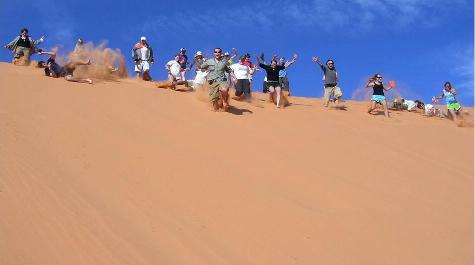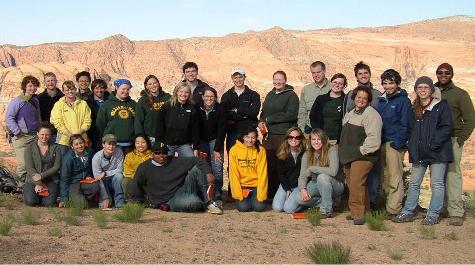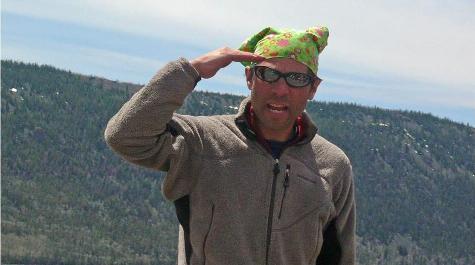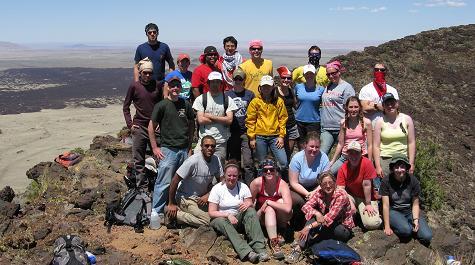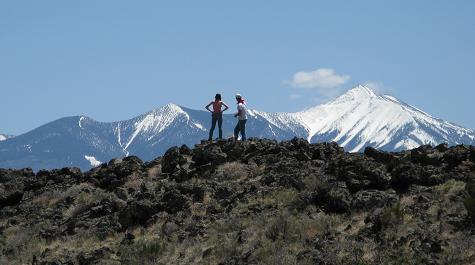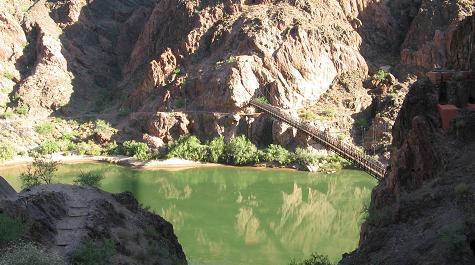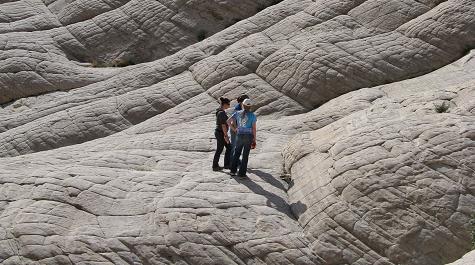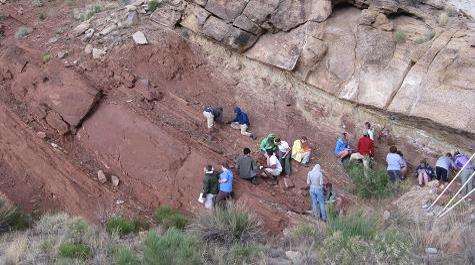Traversing the Colorado Plateau
The Epic Journey of Geology 310's Crew, Summer 2008
Traipsing in the Blue Ridge. Scuttling about that incredible granite exposure at Richmond’s Belle Isle. A departmental trip to the Potomac River’s thundering Great Falls. To our friends, significant others, and parents, it always seems that we geology students are off somewhere for the day, for the weekend, over break, whisked away by professors determined to pry us from desks and texts and bring us to the field. Trevor Buckley’s roommate told him recently, quite exasperatedly, “You guys are just so dedicated! Why?” Dedicated we are, and we don’t think twice about it. You see, there is nothing like geology in the field; as our professors remind us “this is how we learn.” If weekends away seem a radical approach, might we dare propose a month on the road, an ultimate field trip for the aspiring geologist?
Every Spring Semester, William & Mary’s Geology department offers just that with the ever-popular course “Geology 310—Regional Field Geology” that takes undergraduates of all majors and experience levels and gives them the opportunity to do geology by applying classroom principles in the field. The day after graduation, 27 students and Professor Chuck Bailey headed west from Williamsburg. This year’s trip took us to the Colorado Plateau, an expansive region spanning much of New Mexico, Arizona, Utah, and Colorado. The Plateau’s spectacular scenery records the history of the western United States since the Precambrian times (~2 billion years ago), and is a perfect location to study geology.
“Bom Dia”—A Day in the Life of a 310 Student
We emerge reluctantly from our tents just after dawn, greeted by a cheerful “Bom Dia.” Why it’s Professor Bailey bounding through the campground practicing his meager Portuguese—a lovely wake-up call. It’s 7 am, and there is ice on our tents. We huddle around the picnic table consuming hot drinks and oatmeal. Welcome to New Mexico’s Jemez Mountains at nearly 10,000 feet above sea level, where spring has not yet sprung! Breaking camp, we load our three vans–with call signs “Van Morrison,” “Vanna White,” and “Van Halen”—and are off. The class spent the last two days in the Jemez volcanic complex in the Valles Caldera. Leaving the Caldera, discussions within the van range from orographic precipitation (with all the rain!) to columnar jointing in ash flow tuffs. At an overlook above the Rio Grande, students who specialize in environmental geology converse with petrologists about the chemistry of ancient lava flows. Although mesmerizing in its beauty and geologic significance, we are eager to head to lower elevations with warmer temperatures and clear skies. Today, we are on the road again, off to the Painted Desert and Petrified Forest National Park in Arizona.
Just as the sun sets, we make camp in the high desert of northern Arizona. Cook groups assemble their stoves and begin preparing dinner. Quite satisfied—the hunger of both minds and tummies satiated—we sleep under a clear starry sky, eagerly pondering the next day’s journey.
The 310 Experience
Over the three and a half weeks that it took to traverse the southwestern United States and return to W&M, we visited some monumental geologic locales. At the Grand Canyon, we hiked to the Colorado River, descending through the ages to the Precambrian Vishnu Basement—1.8 billion years of geologic history in 4,500 feet of strata. In central Colorado’s Sawatch Range, we ascended Mount Elbert, the highest peak in the Colorado Rockies.
Most challenging of all were our field projects, when we were set loose to discern the lay of the land, investigate the rocks and geologic structures, and work together—conferring on interpretation, composing geologic stories. We mapped the bedrock in eastern Nevada’s desolate Snake Range, pondered the Fremont River’s ancient fluvial terraces near Capitol Reef, Utah, and admired an enormous potassium feldspar crystal on the west slope of the Colorado Rockies. Our efforts generated an incredible synthesis of collective knowledge, talents, and personalities, and no one returned home without a new respect for the significance of geological fieldwork. AJ Saltz summed it up best when she said, “This trip required the combined experience of all of my geology classes—and exposed me to subjects that I had not yet studied in a new and exciting way.” Destination 2009: California, here we come!
Geology 310 by the Numbers:
27± 2 – student members of the 310 crew
1 – dedicated professor leading the charge
25 – nights spent camping
7,000 – miles driven (21,000 miles for all the vans)
29 degrees – lowest temperature
14,440 ft. – highest elevation reached (top of Mt. Elbert, CO)
0 – field books lost














